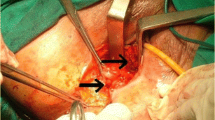Abstract
Purpose
The purpose of this study was to report the outcomes with the use of advancement flaps and bioprosthetic grafts for the management of rectovaginal fistulas.
Methods
A retrospective analysis of prospectively collected data was performed for all patients treated with a rectovaginal fistula.
Results
There were 44 patients in the advancement flap group. A mucosal flap repair was performed for 29 patients, and 15 patients had an anodermal flap repair. The mean follow-up was 10 (range, 6–22) months. There were 34 patients in the bioprosthetic repair group. A bioprosthetic interposition graft was used to repair the fistula in 27 patients with a mean follow-up of 12 (range, 6–22) months, and 7 patients had a bioprosthetic plug repair of their fistula with a mean follow-up of 6 (range, 3–12) months. The fistula recurred in 15 patients (34 percent) who were managed by a flap repair, 5 patients (19 percent) who were managed by a bioprosthetic sheet, and 1 patient (14 percent) who was treated with a bioprosthetic plug.
Conclusions
Use of bioprosthetics for the management of rectovaginal fistulas is a new technique, which, based on early experience, seems to yield results equal to advancement flap repair.


Similar content being viewed by others
References
Rahman MS, Al-suleiman SA, El-Yahia AR, Rahman J. Surgical treatment of rectovaginal fistula of obstetric origin: a review of 15 years experience in a teaching hospital. Obstet Gynaecol 2003;23:607–10.
Ayahn A, Tuncer ZS, Dogan L, Pekin S, Kisnisci HA. Results of treatment in 182 consecutive patients with genital fistulas. Int J Gynaecol Obstet 1995;48:43–7.
Tancer ML, Lasser D, Rosenblum N. Rectovaginal fistula or perineal or anal sphincter disruption or both after vaginal delivery. Surg Gynecol Obstet 1990;171:43–6.
Mazier WP, Senagore AJ, Schiesel EC. Operative repair of anovaginal and rectovaginal fistulas. Dis Colon Rectum 1995;38:4–6.
Watson SJ, Phillips RK. Non-inflammatory rectovaginal fistula. Br J Surg 1995;82:1641–3.
Chew SS, Rieger NA. Transperineal repair of obstetric-related anovaginal fistula. Aust N Z Obstet Gynaecol 2004;44:68–71.
Lowry AC, Thorson AG, Rothenberger DA, Goldberg SM. Repair of simple rectovaginal fistula. Influence of previous repairs. Dis Colon Rectum 1988;31:676–8.
Tsang CBS, Madoff RD, Wong WD, et al. Anal sphincter integrity and function influences outcome in rectovaginal repair. Dis Colon Rectum 1998;41:1141–6.
Khanduja KS, Yamashita HJ, Wise WE Jr, Aguilar PS, Hartmann RF. Delayed repair of obstetric injuries of the anorectum and vagina. A stratified surgical approach. Dis Colon Rectum 1994;37:344–9.
Zimmerman DD, Gosselink MP, Briel JW, Schouten WR. The outcome of transanal advancement flap repair is not improved by an additional labial fat flap transposition. Tech Coloproctol 2002;6:37–42.
Pinedo G, Phillips R. Labial fat pad grafts (modified Martius graft) in complex perianal fistulas. Ann R Coll Surg Engl 1998;80:410–2.
Oom DM, Gosselink MP, Van Dijl VR, Zimmerman DD, Schouten WR. Puborectal sling interposition for the treatment of rectovaginal fistulas. Tech Coloproctol 2006;10:125–30.
Onodera H, Nagayama S, Kohmoto I, Maetani S, Imamura M. Novel surgical repair with bilateral gluteus muscle patching for intractable rectovaginal fistula. Tech Coloproctol 2003;7:198–202.
Pearl RK, Andrews JR, Orsay CP, et al. Role of the seton in the management of anorectal fistulas. Dis Colon Rectum 1993;36:573–9.
White RA, Eisenstat TE, Rubin RJ, Salvati EP. Seton management of complex anorectal fistulas in patients with Crohn’s disease. Dis Colon Rectum 1990;33:587–9.
Scott HJ, Northover JM. Evaluation of surgery for perianal Crohn’s fistulas. Dis Colon Rectum 1996;39:1039–43.
Williams JG, Rothenberger DA, Nemer FD, Goldberg SM. Fistula-in-ano in Crohn’s disease. Results of aggressive surgical treatment. Dis Colon Rectum 1991;34:378–84.
Sher ME, Bauer JJ, Gelernt I. Surgical repair of rectovaginal fistulas in patients with Crohn’s disease: transvaginal approach. Dis Colon Rectum 1991;34:641–8.
Sonoda T, Hull T, Piedmonte MR, Fazio VW. Outcomes of primary repair of anorectal and rectovaginal fistulas using the endorectal advancement flap. Dis Colon Rectum 2002;45:1622–8.
Sangwan YP, Schoetz DJ Jr, Murray JJ, Roberts PL, Coller JA. Perianal Crohn’s disease. Results of local surgical treatment. Dis Colon Rectum 1996;39:529–35.
Michelassi F, Melis M, Rubin M, Hurst RD. Surgical treatment of anorectal complications in Crohn’s disease. Surgery 2000;128:597–603.
Hyman N. Endoanal advancement flap repair for complex anorectal fistulas. Am J Surg 1999;178:337–40.
Makowiec F, Jehle EC, Becker HD, Starlinger M. Clinical course after transanal advancement flap repair of perianal fistula in patients with Crohn’s disease. Br J Surg 1995;82:603–6.
Moore RD, Miklos JR, Kohli N. Rectovaginal fistula repair using a porcine dermal graft. Obstet Gynecol 2004;104:1165–7.
Pye PK, Dada T, Duthie G, Phillips K. Surgisis trademark mesh: a novel approach to repair of a recurrent rectovaginal fistula. Dis Colon Rectum 2004;47:1554–6.
Shelton AA, Welton ML. Transperineal repair of persistent rectovaginal fistulas using an acellular cadaveric dermal graft. Dis Colon Rectum 2006;49:1454–7.
Cintron JR, Park JJ, Orsay CP, et al. Repair of fistulas-in-ano using fibrin adhesive: long-term follow-up. Dis Colon Rectum 2000;43:944–9.
Sentovich SM. Fibrin glue for anal fistulas: long-term results. Dis Colon Rectum 2003;46:498–502.
Ozuner G, Hull TL, Cartmill J, Fazio VW. Long-term analysis of the use of transanal rectal advancement flaps for complicated anorectal/vaginal fistulas. Dis Colon Rectum 1996;39:10–4.
Author information
Authors and Affiliations
Corresponding author
Additional information
Dr. Ellis serves as a paid consultant for Cook Surgical. He has a Research Grant from Cook Surgical to study the long-term efficacy of Cook’s Anal Fistula Plug for treatment of anal fistulas.
About this article
Cite this article
Ellis, C.N. Outcomes After Repair of Rectovaginal Fistulas Using Bioprosthetics. Dis Colon Rectum 51, 1084–1088 (2008). https://doi.org/10.1007/s10350-008-9339-8
Received:
Revised:
Accepted:
Published:
Issue Date:
DOI: https://doi.org/10.1007/s10350-008-9339-8




